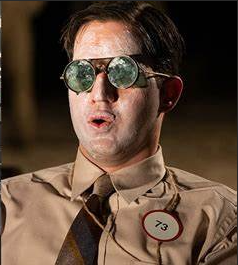
23 Jul ‘Oppenheimer’ Review: Nolan Brings His Grandiose, Propulsive Touch to the Political Drama
The bomb goes off. Total silence immediately takes control. A blinding light fills the desert, Oppenheimer and the rest of his team watch in awe as the flaming mushroom cloud slowly consumes the sky. It’s an image of destructive beauty. Director Christopher Nolan cuts between scientists’ faces, and at first, we see only awe, maybe with a tinge of fear. But then we cut to Edward Teller, watching the explosion with his dark safety glasses on, as his lips turn into a slight smile. This shot of the bespectacled Teller reveling in the cataclysmic power that he was an instrumental part of creating is etched in my mind. Due in large part because it reminded me of Peter Sellers’ titular character in Stanley Kubrick’s Dr. Strangelove: Or How I Learned to Stop Worrying and Love the Bomb. The glasses are definitely part of it, but the two characters also share this mad excitement at the might of nuclear power. In the Kubrick film, Dr. Strangelove is the American president’s scientific advisor, a former Nazi who betrays a certain excitement for the usage of nuclear weapons and particularly a doomsday nuclear device. Edward Teller himself is known as the “father of the hydrogen bomb” and received much support from the American government after the war for his plans to strengthen the American nuclear arsenal. He also was a major advocate of Reagan’s Strategic Defense Initiative, known colloquially as the Star Wars program, a proposed missile defense system that experimented with using lasers, satellites, and particle beam weapons to protect the United States. The similarities between Teller and Strangelove were quite noticeable but I still assumed that Nolan’s inclusion of that smiling shot was probably a coincidence. But then I discovered that Teller was an influence on the character of Strangelove in the 1964 film and now Teller’s wicked smile cannot leave my brain.

He looks so much like Dr. Strangelove. ‘Oppenheimer’ (Universal)
Oppenheimer is an incredibly well-made film. The technical aspects are phenomenal as is par for the course with pretty much every Nolan film. The practical visual effects from the team lead by Andrew Jackson, Scott R. Fisher, and Giacomo Mineo will most likely be Oscar-nominated. The spectacular cinematography and production design from Hoyte van Hoytema and Ruth de Jong, respectively will also very likely receive some Oscar love. But the technical aspect that astounded me the most about the film was Ludwig Goransson’s score. Like with Tenet, Goransson worked with Nolan as the composer on Oppenheimer as Nolan’s regular collaborator Hans Zimmer was busy working on Dune: Part Two (Zimmer wasn’t able to score Tenet due to being committed to Dune: Part One). Goransson’s ‘Tenet’ score was quite possibly the best thing about that film. It’s merger of electronic and classical instrumentation was alternatingly epic with an industrial sound and lush with its ambient soundscapes. Goransson’s work on Oppenheimer drops the industrial sound of his Tenet material but retains the epic feel, once again merging classical and ambient electronic instrumentation. Fluttering string arpeggios morph into pulsating synthesizers on the standout track “Can You Hear The Music” that plays near the start of the film. Like with Nolan’s best films (excluding Memento), the soundscapes that accompany them become integrally intertwined with the film’s content and do so much to drive the emotions of his work.
Cillian Murphy is incredible here. The film lives and dies on his performance and his portrayal of a deeply tortured, anxious man who is forced to present an image of control. He’s phenomenal and is absolutely deserving of all the attention he will likely receive in the coming months. When it comes to the supporting characters, Robert Downey Jr. is the undeniable standout as bureaucrat Lewis Strauss. He has some of the best scenes in the film, some shot in stunning black and white to indicate that it’s his perspective dictating what’s seen on screen (as opposed to the scenes in color which indicate that Oppenheimer’s perspective is being illustrated). A quick aside, the black and white moments in this film look gorgeous, the film becoming the first feature film to use black-and-white analog photography. Emily Blunt, Matt Damon, and Florence Pugh round out the main supporting cast. Unfortunately, Nolan’s problem with under developing female characters persists and while Blunt and Pugh both elevate the material they are given, their roles fall largely into common biopic tropes. Blunt is quite good as the long-suffering wife imploring her husband to fight back against the people attempting to ruin his reputation, and while she feels more “real” than Pugh’s character does, she is still woefully underwritten. Stars like Casey Affleck, Rami Malek, Kenneth Branagh, and Gary Oldman pop up for moments in this film, Affleck’s role as a menacing Commie-hating army officer being the most memorable of the four.

‘Oppenheimer’ (Universal)
Breakneck from the get-go, this undoubtedly is a Nolan movie, with the director’s characteristically propulsive brand of cinema grabbing you by the neck and refusing to let go until the credits run. Like with most Nolan films, the pacing and grandiose nature of the visuals and sonics distract you from paying too close attention to the dialogue. But luckily, unlike Interstellar, no lines are distractingly heavy-handed enough to take you out of the film’s immersion. This is the most political film Nolan has ever made and it’s surprisingly nuanced, something I was unsure the director could do when it came to politics. The film offers many of the prevalent perspectives on the war and the use of the atom bomb, keeping its position on the ramifications of Oppenheimer’s actions ambiguous until the knockout ending. This is one of the most grandiose-feeling films released in quite some time. It feels absolutely massive, the score, the sound, the effects, the pacing, all coming together to create a truly immersive experience. And while it’s so massive, the film is really a character study about one man. The man who became the American Prometheus. Someone so powerful, so deeply destructive with the force he worked so hard to unleash. In portraying Oppenheimer’s guilt, Nolan plays with style to force you inside the man’s tumultuous mind. Scenes like Oppenheimer’s post-Hiroshima speech end up being some of the film’s most chilling as a result of these stylizations.
Truly colossal in a litany of ways, Oppenheimer is Nolan’s best film since Inception and will undoubtedly end up being one of the year’s best blockbusters. Exhilarating and smarter than expected Oppenheimer both succeeds and suffers off of Nolan’s ambition, but the good definitely outweighs the bad. With Oppenheimer, Nolan can confidently silence those who doubted he could return to making box office hits after Tenet underperformed both critically and commercially. Nolan is clearly back, and I expect to see Oppenheimer rack up nominations and maybe a couple of wins come Oscar season.
Score: 4/5
